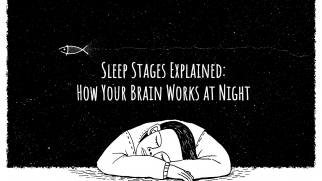How to Touch Someone in Their Sleep Without Waking Them Up?
by | Last UpdatedImagine that your baby fell asleep across the crib with her legs sticking out between the bars. You’ll likely feel the urge to place her normally.
Or, your partner has entwined his extremities around your body. Again. And you need to get some space.
Or, you’re a nurse in the hospital and you need to check the patient but she’s just fallen asleep after an exhausting fever episode.
Whatever the scenario is, the need to move or touch someone in their sleep without waking them up may appear quite often in your life.
And this article will tell what to do so that you’ll be prepared next time.

What Happens with Your Sense of Touch During Sleep?
Even though there’s a lot of information about how the brain works during different sleep stages, there’s still more to cover.
Now, the sense of touch is complex. It’s determined not only by how you move and interact with objects around you but also by how you perceive the environmental factors, such as temperature, wind, materials of your clothes, or another person’s movement close to you.
Turns out, the sense of touch, even though it becomes ‘dimmed’ to some extent, doesn’t switch off completely during sleep.
Along with other senses, it remains active so that you could easily wake up in case of an emergency. However, depending on the sleep stage you’re going through, the sensitivity to the touch may also vary.
See for yourself.
During non-REM sleep, particularly in the deep sleep stage, our brain becomes less susceptible to external stimuli. Deep sleep is usually the lowest point in the brain’s activity, and our body uses this stage to replenish energy. So, if you need to move or touch someone in their sleep without waking them up, the deep sleep stage of NREM sleep is the most suitable for this.
In the Rapid Eye Movement (REM) sleep, we see dreams. As the name implies, the main sign that a person has entered this stage is the eye movement under the eyelids.
Interestingly enough, this sleep stage is also called ‘paradoxical sleep’. Because even though we don’t move a lot during it, our brain activity levels are very close to the waking state or might even outrun it!
Also, REM sleep is when we may respond more to the external factors, depending on how vivid our dreams are. So, it may be much easier to wake a person up if you decide to touch them.
How Can Your Touch Impact One’s Sleep Quality?
It’s common knowledge that the level  of response to external factors varies from person to person. One individual may wake up even from the slightest breeze on their skin, whereas the other may continue sleeping even if you start drilling in the same room.
of response to external factors varies from person to person. One individual may wake up even from the slightest breeze on their skin, whereas the other may continue sleeping even if you start drilling in the same room.
Now, people with a highly sensitive nervous system — such as kids, people with certain illnesses or mental disorders, or those living a stressed life — typically have problems with falling asleep or maintaining the state of sleep.
And if you wake them up with your touch, whether it’s intentional or not, they may have a hard time trying to fall asleep again.
Not to mention that fragmented sleep and sleep deprivation, if accumulated, have a lot of negative outcomes for your health.
Thus, it’s better to avoid waking the person up if you need to touch them during sleep.
Now, let me tell you how to succeed at it, right below.
“Fun fact: Some changes in your sleep environment might have an impact on the content of your dreams. For example, a sudden gust of cold wind from your window might cause you to dream about the Arctic, while the smell of flowers might translate into some pleasant sceneries.”
How to Keep Someone Asleep While Touching Them: 4 Common Scenarios
So, let’s see your possible actions in the four most common situations when you may need to touch or move someone who’s sleeping without waking them up.
#1 Your Baby
Babies look irresistibly cute while they’re asleep, and it’s totally understandable that you just cannot help yourself but touch their small feet, hands, or head.
The thing is, babies are very sensitive sleepers and may wake up very easily. And if you’re going through the wonders of parenthood, you know that a baby who didn’t sleep well is a nightmare for the whole family.
But sometimes you still need to touch your little one — for example, to measure the temperature or to move her into a more comfortable or safer sleeping position.
And the goal in these cases is to determine how deep is your baby’s sleep at the moment. Here’s how to do it:
- Check the eye movement and breath. During the deep sleep stage, the eye movement is absent and the breath is slow and deep. If you notice these signs, you can move or touch your baby without being worried that you’ll wake her up.
- Try to induce grasp reflex. The grasp reflex is controlled by motor neurons, which also have reduced activity during the deep sleep stage. So, you can gently rub your baby’s palm and see if she grasps your finger.
- Move her hands. You can gently lift your baby’s hand — but not too high — and drop it. If she remains asleep after that, you can surely move her.
However, your little one may still start waking up when you try to move her, say, from your bed to the crib. In this case, you can gently pat her tummy until she feels relaxed again. Or, if your baby has learned the self-soothing skill, you can just wait and allow her to calm on her own once in the crib.
#2 A Snoozing Friend
If your friend has stretched across the couch in an uncomfortable position, you might feel the desire to help them get cozy.
Because that’s what friends are for, right?
So, checking the sleep stage is the starting point. Again, look for such signs as deep breathing and no eye movement under the eyelids, or try the trick with raising up a person’s hand and dropping it.
Now, let’s get to the moving part. Here’s what you can try:
- Apply gentle pressure. Start with a gentle push and gradually increase the pressure to encourage the person to turn over.
- Move one step at a time. Inspecting a person’s position can help you figure out how to accommodate them. For example, you can use a person’s natural inclination and push them into the comfier position. In this case, gravity will help you do it in a more natural way so you won’t disrupt your friend’s sleep.
- Add some coziness. Maybe your friend’s sleeping in a weird position happened because they froze or because your pet curled up near their legs. In this case, simply adding an extra blanket or removing the irritant could add some comfort, helping the person relax and adjust to a more suitable sleeping position naturally.
#3 Sleeping Partner
Perhaps the most common scenario when you want to keep someone asleep while touching them includes your sleeping partner, especially if he or she is an active sleeper.
Sometimes, they may migrate around the mattress area and shift you to the edge until you feel uncomfortable. Or, they may just hug you like a bear so you need a little more space to simply breathe.
The good news is, you can easily deal with these inconveniences using the same scheme I’ve mentioned above.
First, check how deep the sleep of your partner is.
Second, try to regain some space by gently pushing them to the other side of the bed. Start with light and gentle movements and slowly increase the pressure. And again, use the gravity in your favor and move the person according to their inclinations so that it feels more natural to them.
Also, you may use the same steps if your partner is a snorer. Sometimes, simply turning their head to the side may reduce snoring and help you sleep better.
“Remember that communication is key in every relationship. So, you should speak to your partner if their way of sleeping affects your sleep, and find a compromise acceptable for both.”
#4 Patient in the Hospital
Working in healthcare is a pretty stressful job by itself. Since some of your patients might be dealing with severe pain or have very sensitive sleep due to medications, you may not have any desire to accidentally wake them up.
But if you need to check the vital signs or perform some other procedures, here are the steps to make:
- For checking the vital signs: Try to maintain steady contact with the point you’re applying pressure to. Do not twitch your hand or move too fast, as this can easily wake the person up. For checking the temperature, gently place the rear side of your palm onto a person’s forehead and slowly press for a couple of seconds.
- For equipment adjustments: If the person is very active in their sleep and they move the tubes and cords that are wired to them, you might need to adjust them from time to time. Again, do not move fast and take one step at a time. If you need to place an extra patch to fix the dropper tube, use the same gradual pressure as you would do with a pulse monitoring, and place the patch where you need it.
- For moving the patient: Start with a gentle touch and slowly increase the pressure while moving the person to the side you want to. Try to maintain steady contact with the person while you’re moving them and make your motions smooth, without any sharp impulses.
If the patient is heavy, you may need help. In this case, try to precisely coordinate your movements with the person helping you, to reduce the impact of accidental impulses.
Do you have your own tips on how to move or touch a sleeping person? If yes, we’d love to know them. Feel free to share below!




No Comments